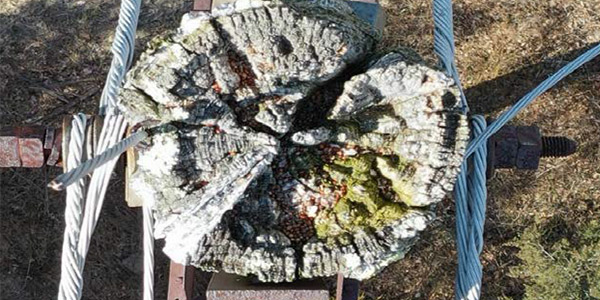Eversource last week presented the ISO-NE Planning Advisory Committee with plans for two projects that would replace copper conductor and shield wire and 345-kV structures at a cost of nearly $500 million.
The copper conductor and shield wire project would cover 673 structures in Connecticut, Massachusetts and New Hampshire at an estimated $311.1 million. The in-service dates on the project range from the second quarter of this year through the fourth quarter of 2023.
The 345-kV replacements include 567 structures in the same states at about $181 million, according to Eversource’s Chris Soderman, who put forward both projects to the PAC. The work is expected to take place this year and next.
Soderman said Eversource periodically tests samples of copper conductor and shield wire obtained from existing lines during repairs and maintenance. Both materials are susceptible to thermal degradation as well as deterioration because of environmental factors.
Recent test results indicate that outer copper conductor strands have visible verdigris and black oxide in addition to excessive elongation in some strands, potentially caused by overheating. There was also severe corrosion of shield wire, and copper conductors are no longer an industry standard, making spare parts difficult to obtain. Failure of copper conductor or shield wire presents a safety hazard and creates risks to the transmission system’s reliable operation.
Soderman added that Eversource transmission lines with copper conductor or shield wire tend to be old. Copper conductor has not been installed since 1960 and shield wire since 1990. Most of the company’s transmission lines containing these materials also suffer from other age-related deficiencies and deterioration such as wood pole asset condition issues, steel lattice tower deterioration and lack of secure, high-speed telecommunications infrastructure. Soderman said many of those issues could be addressed when performing the replacements. Ultimately, Eversource will replace 80.1 miles of copper conductor and 157.6 miles of shield wire.
One stakeholder questioned Soderman about Eversource spending hundreds of millions of dollars replacing 115-kV lines with lines of the same ratings as part of the project and asked if the utility is considering an upgrade to 345-kV lines for future grid needs. Soderman said the company is reviewing possible upgrades but is seeking to strike a balance between current and future grid needs. The utility is also awaiting results of the Future Grid Initiative reliability study to better understand projected grid needs. (See ISO-NE Provides Initial Feedback on ‘Future Grid’ Study.)
Eversource manages approximately 1,250 miles of 345-kV overhead lines and over 9,000 345-kV structures. The majority of the New England 345-kV system was constructed in the 1960s and 1970s, and the structures targeted by these projects are typically wood, single-circuit structures in an H-frame configuration. Eversource will replace 6.3% of its wooden structures with light-duty tubular steel poles. The new installations must comply with current clearance and strength code requirements.
Soderman said the use of drones in inspections has resulted in a significant increase in identified defects, which indicate substantial decay and decreased load-carrying capacity of aging 345-kV wood structures. High-definition cameras on drones allow inspectors to see possible damage from all angles and take better photos of insect and woodpecker damage, pole top rot, severe fracturing, and hardware and insulator damage.
Most of the work for both projects will take place in Connecticut, where replacement of 30.1 miles of copper conductor and 70.7 miles of shield wire will cost $151 million and cover 322 structures. The 345-kV replacements in that state will include 414 structures at the cost of $135.4 million.
New Chair
Peter Bernard, PAC chair since October 2016, will step down after February’s meeting to spend more time on other duties in the RTO’s system planning department, where he is the manager of transmission planning. Bernard joined ISO-NE in 2009, following more than 15 years with National Grid, and has been directly involved in implementing FERC Order 1000 practices and procedures for the RTO during his tenure.
ISO-NE is proposing Jody Truswell to fill the role of PAC chair, according to a memo announcing Bernard’s departure. Truswell is a senior project coordinator for transmission service at ISO-NE and the project manager for all offshore wind interconnection requests. She would become chair for the PAC’s meeting in March.



